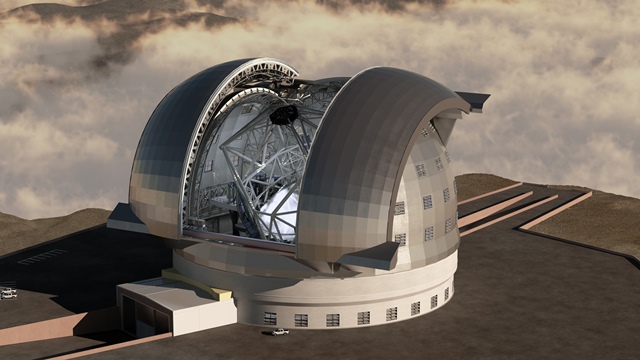Clear view for the Extremely Large Telescope – LZH develops IR narrowband filter

Image of the planned E-ELT, in which the IR narrowband filter of the LZH can be found. Swinburne Astronomy Productions/ESO
In contrast to telescopes stationed in outer space, earth based telescopes inevitably measure interference signals in the atmosphere. In order to filter out this static, scientists at the LZH are developing special coatings for the optical components of the E-ELT. The work group Coatings has already developed first filters with a thickness of 60 to 100 µm on a substrate with a diameter of 100 mm. The narrowband filters block out interference and transmit signals into space in narrow bands in the infrared range (IR). The coating, made using ion beam sputtering, must have a homogeneity of 0.1% or less.
Filters make more exact measuring possible
Production of complex filters is a challenge, since a compromise between the coating thickness and the quality must always be found. Because of this, Dr. Stefan Günster, head of the Coatings Group, works closely with the astronomers of the Max Planck Institute for Extraterrestrial Physics and the University Observatory of the Ludwig-Maximilian-Universität München. The filter coating should improve the signal-to-noise ratio. This means the measurement time can be shortened, and thus more exact measurements are possible.
The scientists working with Dr. Günster use a special wideband filter monitor developed by the LZH, which covers a very wide wavelength range of 380 to 1700 nm. “With this instrument we can monitor the coating during production, and optimize it if necessary”, explains Stefan Günster. “Since coating the filter is very sophisticated, due to its thickness, we can save considerable development time doing so.”
Examining form accuracy
The relatively high physical thickness of the coatings places mechanical stress on the optics: the filters are deformed and influence the measurements. “We are presently working on processes, which can be used to monitor and control the form accuracy of the optics,” adds Dr. Günster.
As soon as the coating process has become established, the narrowband filters can also be used in other areas: for example for biological and medical applications that need high quality measurements in the IR range.
The Coating Group will be at the Optatec from May 20th to 22nd, 2014, in Hall 3, Stand H39.
Media Contact
More Information:
http://www.lzh.deAll latest news from the category: Physics and Astronomy
This area deals with the fundamental laws and building blocks of nature and how they interact, the properties and the behavior of matter, and research into space and time and their structures.
innovations-report provides in-depth reports and articles on subjects such as astrophysics, laser technologies, nuclear, quantum, particle and solid-state physics, nanotechnologies, planetary research and findings (Mars, Venus) and developments related to the Hubble Telescope.
Newest articles

Sea slugs inspire highly stretchable biomedical sensor
USC Viterbi School of Engineering researcher Hangbo Zhao presents findings on highly stretchable and customizable microneedles for application in fields including neuroscience, tissue engineering, and wearable bioelectronics. The revolution in…

Twisting and binding matter waves with photons in a cavity
Precisely measuring the energy states of individual atoms has been a historical challenge for physicists due to atomic recoil. When an atom interacts with a photon, the atom “recoils” in…

Nanotubes, nanoparticles, and antibodies detect tiny amounts of fentanyl
New sensor is six orders of magnitude more sensitive than the next best thing. A research team at Pitt led by Alexander Star, a chemistry professor in the Kenneth P. Dietrich…





















